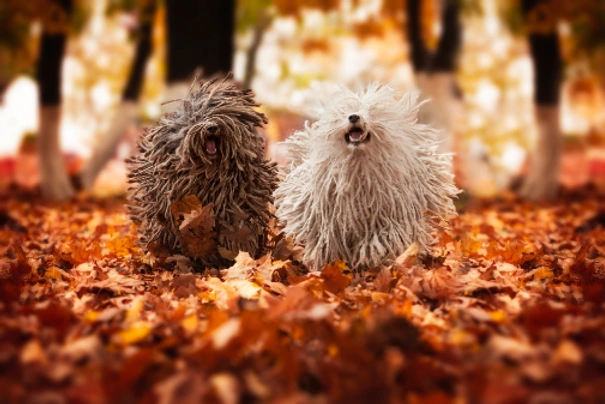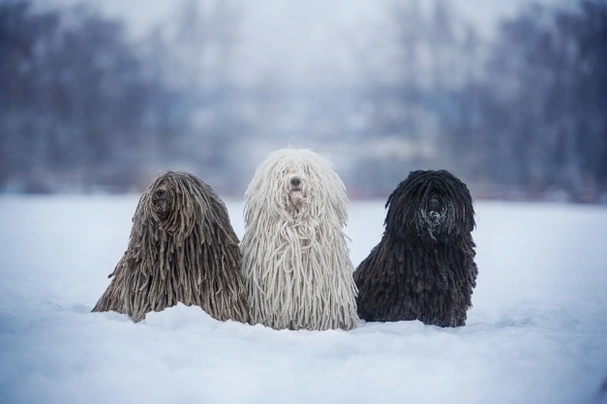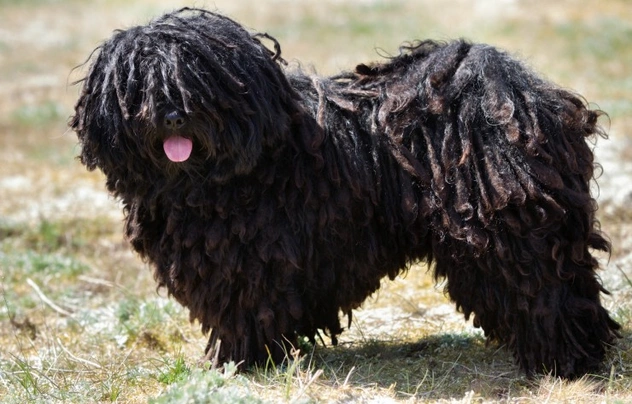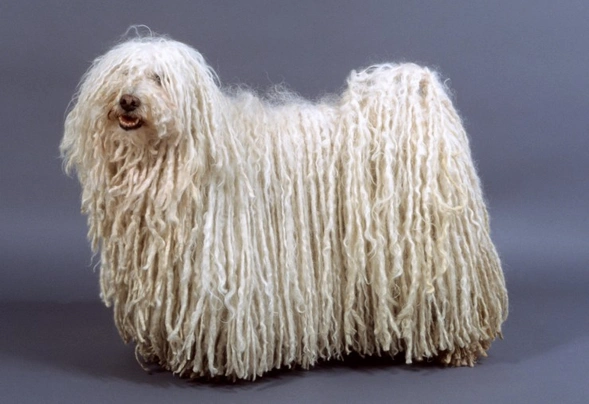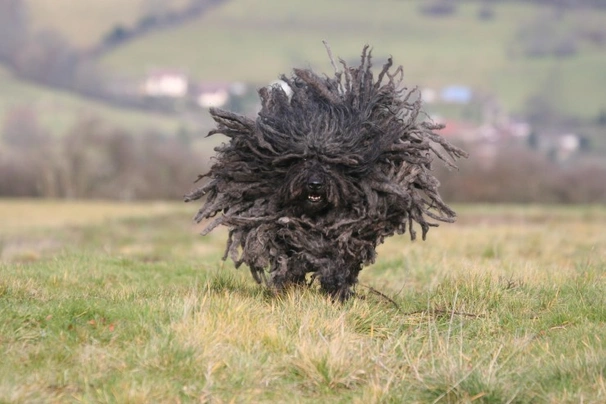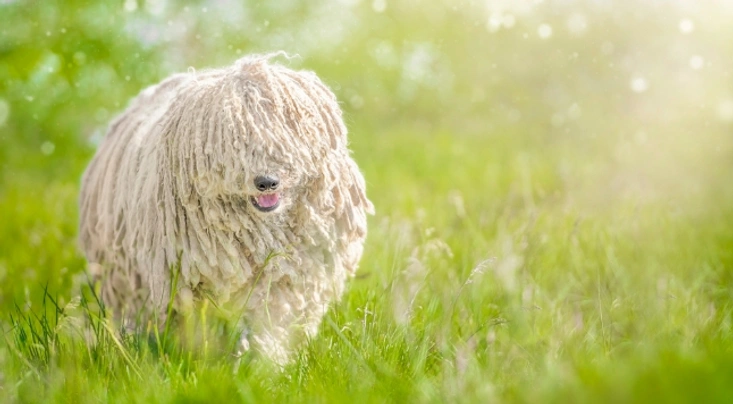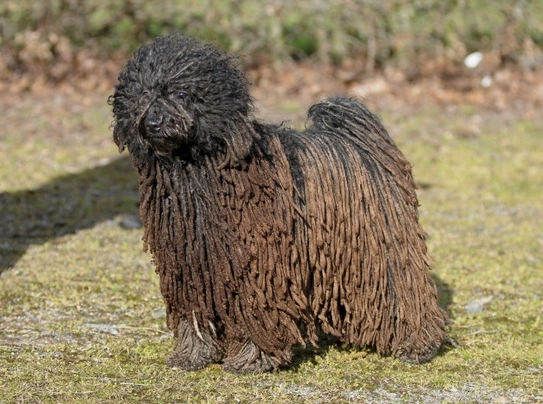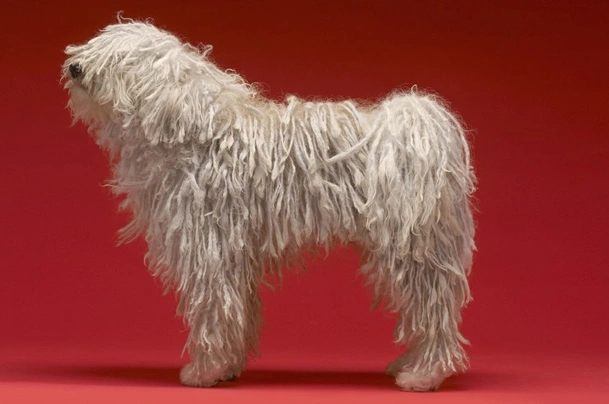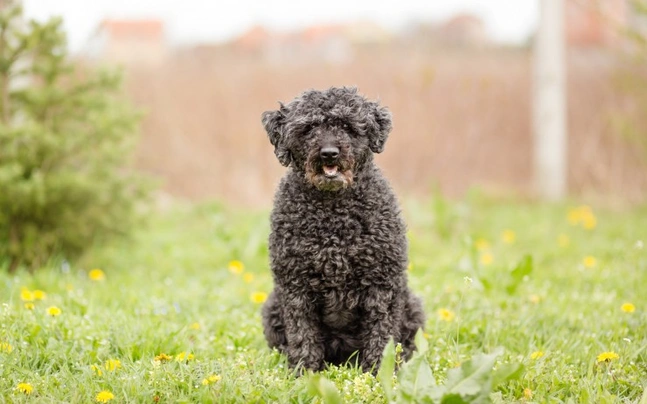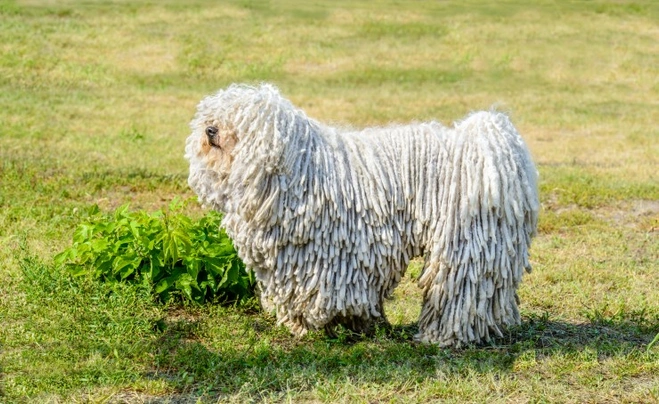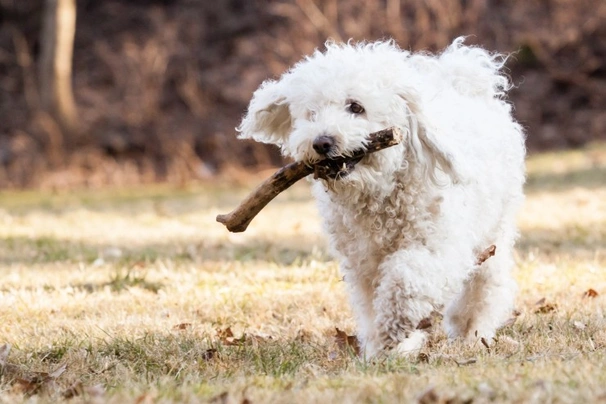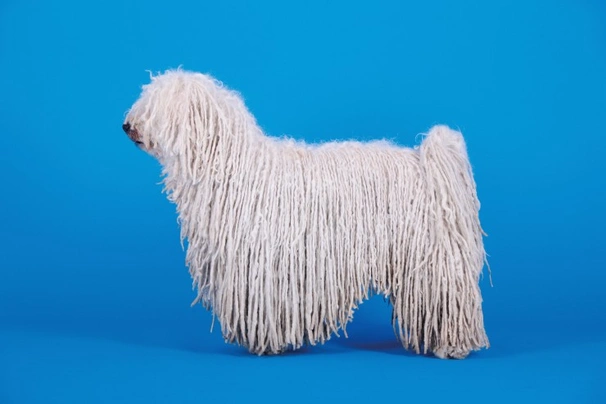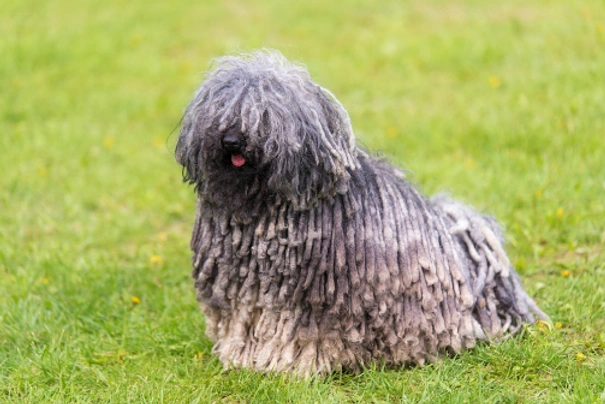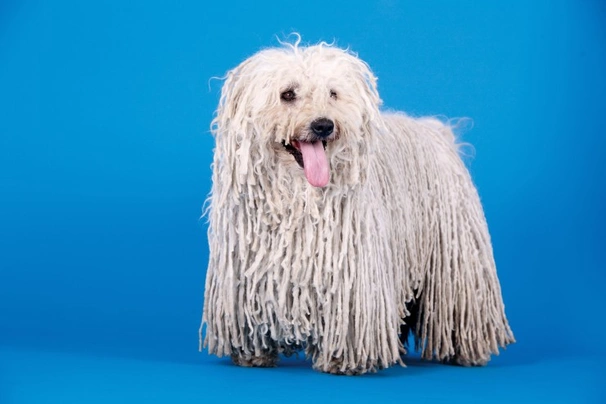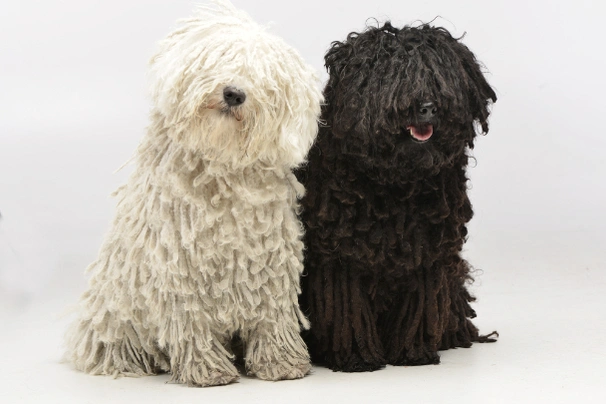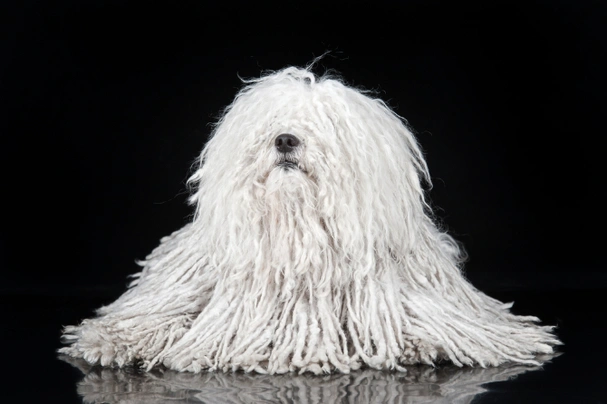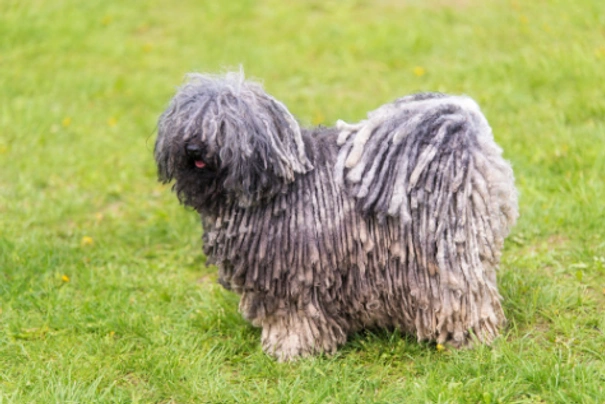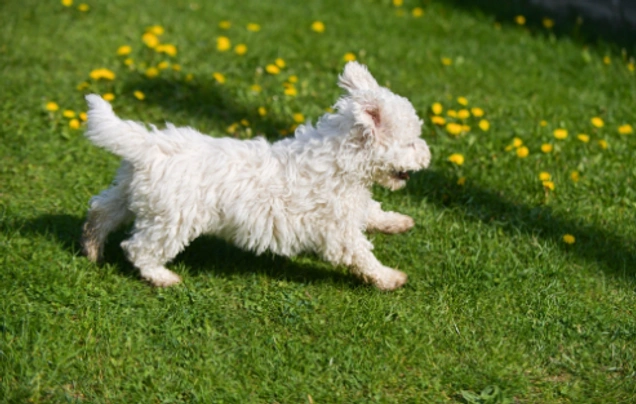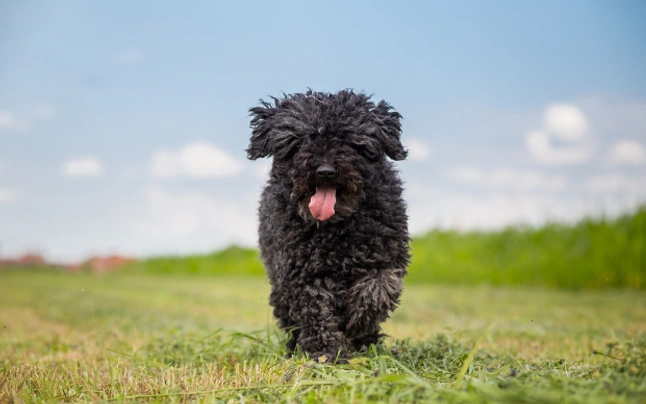Hungarian Puli
Pros
Cons
Introduction of the Hungarian Puli
Hungarian Puli are very distinctive looking dogs and as their name suggests they were first bred in Hungary to be herding dogs. They boast having a dense thick corded coat which offers a tremendous amount of protection from the elements and harsh Hungarian winters something the Puli needed when herding and guarding flocks with their shepherds in remote mountainous terrains around the country.
Today the Puli is gaining popularity as a companion and family pet in many other parts of the world including the UK and for good reason. Not only are they extraordinary looking but they boast lively energetic kind and trustworthy natures. They tend to form very strong bonds with one member of a household although they always show affection towards other people in the household. With this said puppies can often command a lot of money and waiting lists tend to be long so anyone wanting to share a home with a Hungarian Puli might need to wait a while for the pleasure of doing so.
History of the Hungarian Puli
Although the actual origin of the Hungarian Puli remains a bit of a mystery it is thought they were introduced to many European regions of the world by the Magyars during the 9th century. As such there is a theory that the breed first originated in Asia and not Europe. In Hungary the Puli was used to help shepherds herd and guard large flocks in some of the most challenging terrains of the country. Their ultra-thick corded coats not only offered these dogs a tremendous amount of protection against harsh Hungarian winters and the elements but they also protected dogs when they were attacked by wolves and other predators that preyed on the flocks that Pulik were guarding.
These lovely dogs were virtually unheard of in other countries of the world right up until more recent times because Hungarian shepherds protected their dogs keeping them a closely guarded secret. They referred to them as "Hungarian Legends" and as such the breed was not influenced in any way by the outside world. The Puli was so highly prized just a few decades ago for their skills and abilities that Hungarian Shepherds were willing to pay a year's wages just to own one of these charming and loyal dogs.
Today these lovely dogs with their distinct corded coats have found their way into the hearts and homes of many people throughout the world including in the UK where they enjoy great success in the show ring too. With this said it is still hard to find puppies and anyone wanting to share a home with a Puli might have real trouble finding a well-bred puppy. In short anyone wanting to share a home with a Hungarian Puli might have to go on an extremely long waiting list after registering their interest with responsible breeders.
Interesting facts about the breed
- Is the Hungarian Puli a vulnerable breed? No they have found a real fanbase in the UK and although waiting lists can be long and puppies expensive the number of Pulik is increasing every year
- The plural for Puli is Pulik and not Pulis
- Their lovely corded coats start to develop when dogs are still young but once the cords are formed it does not take too much to keep a Puli’s coat in good condition
Appearance of the Hungarian Puli
Height at the withers: Males 40 - 44 cm Females 37 - 41 cm
Average weight: Males 13 - 15 kg Females 10 - 13 kg
Under their thick corded coat the Hungarian Puli is a well-muscled sturdy yet wiry dog. The hair around their eyes acts like an umbrella completely covering a dog’s eyes from view. Pulik have quite small heads which are slightly domed with a well-defined stop and nicely proportioned muzzle it is just very hard to see. Their eyes always boast a lively expression medium in size and a nice dark brown colour. Noses are large and black adding to a dog's charming appearance.
Ears are V-shaped and set quite low being pendulous medium in size and well covered in hair. However a Pulik's ears are well hidden by their coat even when these dogs are alert. The roof of a dog's mouth is either dark in colour or it can be pigmented with dark spots. Lips are black and tight but a Puli's tongue is red. These dogs have a perfect scissor bite where their upper teeth neatly overlap their lower ones all set on a nice square jaw.
A Puli's neck is set at a very distinct 45-degree angle and is well-muscled and moderately long. However it is hard to distinguish it under a dog’s full coat. Their shoulders are well laid back and their front legs are well muscled and straight.
A Puli's withers are slightly higher than the level of their back which is moderately long. Loins are broad and short and their belly is a nicely tucked up. Their ribs are deep and well sprung with dogs boasting a short rump that slopes slightly although the trait is hardly noticeable due to the way a dog's tail is so tightly curled.
Hindquarters are well-muscled and strong with a dog's pelvis creating a 90-degree angle from their thigh bone. Back legs are strong and muscular. Their feet are round short and tight with back feet being slightly longer than a dog's front ones. Their nails are black or grey in colour and extremely strong. Paw pads are dark grey and springy to the touch. A Puli's tail is moderately long and dogs carry them tightly curled over their loins although because of the density and texture of a Puli's coat it is hardly distinguishable.
When it comes to their coat the Hungarian Puli boasts an extremely thick and dense corded one that’s free from any felting or matting. Their cords tend to be longer over their hindquarters and shorter on a dog's head and their feet. Some Pulik boast having coats that grow right down to the ground. The acceptable colours for Kennel Club registration are as follows:
- Black
- Fawn
- Grey
- White
Pulik with fawn or grey coloured coats can have black or white hairs throughout their coats and may have grey tips to their ears and tails which is acceptable as a breed standard. It is also worth noting that the breed colours which are acceptable for Kennel Club registration can differ to those that are set out in a dog’s breed standard.
Gait/movement
When a Puli moves their strides are not very far-reaching and which includes at the gallop. Their gait is short stepping and quick which matches a dog’s nature and disposition.
Faults
The Kennel Club frowns on any exaggerations or departures from the breed standard and would judge the faults on how much they affect a dog's overall health and wellbeing as well as their ability to perform.
Males should have both testicles fully descended into their scrotums and it is worth noting that a dog can be a little lighter or heavier as well as slightly taller or shorter than set out in the Kennel Club breed standard which is only given as a guideline.
Temperament of the Hungarian Puli
The Hungarian Puli is an extremely intelligent dog they are loyal and lively characters that tend to form a very strong bond with one person in a household. In short the Puli is known to be a "one-man dog". They can be a little wary of strangers but unless they feel threatened in any way they rarely show any aggression toward people they don't know. However if a Puli feels anxious or threatened in any way they will growl and may even snap if a person gets too close to them.
Puppies need to be well socialised from a young age for them to be more confident outgoing characters and a Puli's training must start as early as possible to curb any of their strong desires to herd everything they come across. They also boast a very strong desire to guard things which can become a problem if a Puli is allowed to get too protective of their toys or food.
However a Hungarian Puli is a good choice for first time owners because they are quite easy to train. With this said anyone sharing a home with a Puli has to be ready for some serious coat maintenance especially in puppies and adolescent dogs which is a time when their cords are just forming.
Are they a good choice for first time owners?
The Hungarian Puli is not the best choice for first time owners because they need to be socialised handled and trained by people who are familiar with the specific needs of a highly intelligent energetic and often wilful dog that could easily get the better of a novice owner.
What about prey drive?
The Pulik has a very high prey drive and will happily chase anything that moves just for the fun of it. As such care should always be taken as to where and when a Puli can run off the lead more especially if there is wildlife and/or livestock close by. Care must also be taken when introducing a Puli to any smaller animals and pets.
What about playfulness?
Pulik have a very playful and fun-loving side to their natures and love nothing more than to entertain and be entertained. They are known to be a little mischievous when the mood takes them and being so clever a Puli quickly learns how to get their own way.
What about adaptability?
Pulik are highly adaptable dogs and providing they are given enough daily physical exercise combined with as much mental stimulation as possible to prevent boredom from setting in they are just as happy living in an apartment in town as they are living in a house in the country. With this said like other energetic and active breeds they enjoy being able to roam around in a secure back garden whenever possible so they can really let off steam.
What about separation anxiety?
Pulik form strong ties with their families and dogs are never very happy when they find themselves left on their own for longer periods of time. They are better suited to people who either work from home or in households where one person stays at home when everyone else is out so they are never alone for any length of time which could see a dog suffering from separation anxiety. This can lead to them being destructive around the home which is a dog's way of relieving any stress they are feeling and a way to keep themselves entertained which could include barking incessantly to show how unhappy they are at the situation.
What about excessive barking?
Some Pulik like the sound of their own voices a little too much which is something that needs to be gently nipped in the bud when a dog is still young being careful not to frighten them. Others will only bark when there are strangers about or when something they don't like is going on in their surroundings because they are always on the alert and like to know what’s going on.
Do Hungarian Pulik like water?
Most Pulik love swimming and will take to the water whenever they can more especially when the weather is hot. However if anyone who owns a dog that does not like water should never force them to go in because it would just end up scaring them. With this said care should always be taken when walking a Pulik off the lead anywhere near more dangerous watercourses just in case a dog decides to leap in and then needs rescuing because they cannot get out of the water on their own. It is also very important for a dog’s coat to be thoroughly dried off because if moisture is trapped in their cords it could lead to a skin allergy flaring up.
Are Hungarin Pulik good watchdogs?
Pulik are natural watchdogs because they are always on the alert to what goes on in their surroundings. As such they are always quick off the mark to let an owner know when strangers are about bearing in mind that Pulik are naturally wary of people they don’t know anyway.
Intelligence / Trainability of the Hungarian Puli
Pulik are highly intelligent and they are always eager and willing to please which means in the right hands and with the right sort of guidance these dogs are quite easy to train. The key to successfully training a Puli is to make sure their education is always consistent and fair. When these dogs are well trained and socialised correctly from a young age they excel at many canine sports which includes obedience and agility.
Like all puppies Pulik puppies are incredibly cute and it is all too easy to spoil them when they first arrive in their new homes. However puppies quickly grow up to be mature dogs and because a Puli is so intelligent they quickly learn new things which includes the good and the bad. As such when a puppy is nicely settled into their new home they must be taught the ground rules which helps them understand acceptable behaviour and what is not acceptable. Setting out boundaries also helps establish a “pecking order” and who is alpha dog in a household which prevents a dog from developing a more dominant side to their nature. The first commands a puppy should be taught are as follows:
- Come
- Sit
- Stay
- Heel
- Quiet
- Leave it
- Down
- Bed
Children and other
Pulik are generally pretty good around children but they are lively and energetic characters which means they could quite accidentally knock a smaller child over. As such any interaction between the kids and a dog should be supervised by an adult to make sure play time does not get too boisterous.
Care has to be taken when a Puli is around smaller pets but in general they get on well with other dogs and are tolerant of cats if they have grown up together. However a Puli might well chase a neighbour’s cat if they wander into a dog's back garden.
Health of the Hungarian Puli
The average life expectancy of a Hungarian Puli is between 9 and 15 years when properly cared for and fed an appropriate good quality diet to suit their ages.
Pulik are known to be robust dogs that don't suffer from too many of the health issues that plague other pure breeds. The health concerns that seem to most affect the breed and which are worth knowing about if you are hoping to share your home with one of these extraordinary looking dogs include the following:
- Hip Dysphasia – dogs must be hip scored through the KC/BVA scheme
- Multifocal Retinal Dysplasia (MRD) – dogs must be eye tested
- Congenital deafness – white coated dogs should be BAER tested through the Animal Health Trust (AHT)
- Progressive Retinal Atrophy (PRA) - Tests available
- Bardet Biedl Syndrome (BBS) - DNA Test Available
- Degenerative myelopathy
- Cataracts
What about vaccinations?
Pulik puppies would have been given their initial vaccinations before being sold but it is up to their new owners to make sure they have their follow-up shots in a timely manner with the vaccination schedule for puppies being as follows:
- 10 -12 weeks old bearing in mind that a puppy would not have full protection straight away but would be fully protected 2 weeks after they have had their second vaccination
There has been a lot of discussion about the need for dogs to have boosters. As such it's best to talk to a vet before making a final decision on whether a dog should continue to have annual vaccinations which are known as boosters.
What about spaying and neutering?
A lot of vets these days recommend waiting until dogs are slightly older before spaying and neutering them which means they are more mature before undergoing the procedures. As such they advise neutering males and spaying females when they are between the ages of 6 to 9 months old and sometimes even when a dog is 12 months old.
Other vets recommend spaying and neutering dogs when they are 6 months old but never any earlier unless for medical reasons. With this said many breeds are different and it is always advisable to discuss things with a vet and then follow their advice on when a dog should be spayed or neutered.
What about obesity problems?
Like other breeds Some Pulik gain weight after they have been spayed or neutered and it's important to keep an eye on a dog's waistline just in case they do. If a dog starts to put on weight it's important to adjust their daily calorie intake and to up the amount of exercise they are given. Older dogs too are more prone to gaining weight and again it's essential they be fed and exercised accordingly because obesity can shorten a dog's life by several years. The reason being that it puts a lot of extra strain on a dog's internal organs including the heart which could prove fatal.
What about allergies?
Some Pulik are prone to suffering from allergies and it's important for a dog to see a vet sooner rather than later if one flares up. Allergies can be notoriously hard to clear up and finding the triggers can be challenging. With this said a vet would be able to make a dog with an allergy more comfortable while they try to find out the triggers which could include the following:
- Certain dog foods that contain high levels of grains and other cereal type fillers
- Airborne pollens
- Dust mites
- Environment
- Flea and tick bites
- Chemicals found in everyday household cleaning products
Participating in health schemes
All responsible Hungarian Puli breeders would ensure that their stud dogs are tested for known hereditary and congenital health issues known to affect the breed by using the following schemes:
- Hip Dysplasia – dogs must be hip scored through the KC/BVA scheme
- Multifocal Retinal Dysplasia (MRD) – dogs must be eye tested
- Congenital deafness – white coated dogs should be BAER tested through the Animal Health Trust (AHT)
What about breed specific breeding restrictions?
Apart from the standard breeding restrictions on all Kennel Club recognised breeds there are no other breed specific breeding restrictions in place for the Hungarian Puli.
What about Assured Breeder Requirements?
It is mandatory for all Kennel Club Assured Breeders to use the following scheme on their dogs and all other breeders are strongly advised to follow suit:
The Kennel Club also strongly advises all breeders to use the following scheme on their dogs:
- Eye testing for Multifocal Retinal Dysplasia (MRD)
- Bitches under the age of 18 months old should not be used for breeding purposes
Caring for the Hungarian Puli
As with any other breed these dogs need to be groomed on a regular basis to make sure their coats and skin are kept in top condition. They also need to be given regular daily exercise to ensure they remain fit and healthy. On top of this they need to be fed good quality food that meets all their nutritional needs throughout their lives.
Caring for a Hungarian Puli puppy
Pulik puppies are boisterous and full of life which means it's essential for homes and gardens to be puppy-proofed well in advance of their arrival. A responsible breeder would have well socialised their puppies which always leads to more outgoing confident and friendly dogs right from the word go. With this said any puppy is going to feel vulnerable when they leave their mother and littermates which must be taken into account. The longer a puppy can remain with their mother the better although it should never be for too long either.
It's best to pick a puppy up when people are going to be around for the first week or so which is the time needed for a puppy to settle in. Puppy-proofing the home and garden means putting away any tools and other implements that a boisterous puppy might injure themselves on. Electric wires and cables must be put out of their reach because puppies love chewing on things. Toxic plants should be removed from flowerbeds and the home too.
Puppies need to sleep a lot to grow and develop as they should which means setting up a quiet area that's not too out of the way means they can retreat to it when they want to nap and it's important not to disturb them when they are sleeping. It's also a good idea to keep "playtime" nice and calm inside the house and to have a more active "playtime" outside in the garden which means puppies quickly learn to be less boisterous when they are inside.
The documentation a breeder provides for a puppy must have all the details of their worming date and the product used as well as the information relating to their microchip. It is essential for puppies to be wormed again keeping to a schedule which is as follows:
- Puppies should be wormed at 6 months old
- They need to be wormed again when they are 8 months old
- Puppies should be wormed when they are 10 months old
- They need to be wormed when they are 12 months old
Things you'll need for your puppy
There are certain items that new owners need to already have in the home prior to bringing a new puppy home. It's often a good idea to restrict how much space a puppy plays in more especially when you can't keep an eye on what they get up to bearing in mind that puppies are often quite boisterous which means investing in puppy gates or a large enough playpen that allows a puppy the room to express themselves while keeping them safe too. The items needed are therefore as follows:
- Good quality puppy or baby gates to fit on doors
- A good well-made playpen that's large enough for a puppy to play in so they can really express themselves as puppies like to do
- Lots of well-made toys which must include good quality chews suitable for puppies to gnaw on bearing in mind that a puppy will start teething anything from when they are 3 to 8 months old
- Good quality feed and water bowls which ideally should be ceramic rather than plastic or metal
- A grooming glove
- A slicker brush or soft bristle brush
- Dog specific toothpaste and a toothbrush
- Scissors with rounded ends
- Nail clippers
- Puppy shampoo and conditioner which must be specifically formulated for use on dogs
- A well-made dog collar or harness
- A couple of strong dog leads
- A well-made dog bed that's not too small or too big
- A well-made dog crate for use in the car and in the home that's large enough for a puppy to move around in
- Baby blankets to put in your puppy's crate and in their beds for when they want to nap or go to sleep at night
Keeping the noise down
All puppies are sensitive to noise including Pulik puppies. It's important to keep the noise levels down when a new puppy arrives in the home. TVs and music should not be played too loud which could end up stressing a small puppy out making them withdrawn timid and shy.
Keeping vet appointments
As previously mentioned Pulik puppies would have been given their first vaccinations by the breeders but they must have their follow up shots which is up to their new owners to organise. The vaccination schedule for puppies is as follows:
- 10 -12 weeks old bearing in mind that a puppy would not have full protection straight away but would only be fully protected 2 weeks after they have had their second vaccination
When it comes to boosters it's best to discuss these with a vet because there is a lot of debate about whether a dog really needs them after a certain time. However if a dog ever needed to go into kennels their vaccinations would need to be fully up to date.
What about older Hungarian Pulik when they reach their senior years?
Older Pulik need lots of special care because as they reach their golden years they are more at risk of developing certain health concerns. Physically a dog's muzzle may start to go grey but there will be other noticeable changes too which includes the following:
- Coats become coarser
- A loss of muscle tone
- Pulik can either become overweight or underweight
- They have reduced strength and stamina
- Older dogs have difficulty regulating their body temperature
- They often develop arthritis
- Immune systems do not work as efficiently as they once did which means dogs are more susceptible to infections
- Older dogs change mentally too which means their response time tends to be slower as such they develop the following:
- They respond less to external stimuli due to impaired vision or hearing
- They tend to be a little pickier about their food
- They have a lower pain threshold
- Become intolerant of any change
- Often an older dog can feel disorientated
Living with a Hungarian Puli in their golden years means taking on a few more responsibilities but these are easily managed and should include taking a look at their diet the amount of exercise they are given how often their dog beds need changing and keeping an eye on the condition of their teeth.
Older Pulik need to be fed a good quality diet that meets their needs at this stage of their lives all the while keeping a close eye on a dog's weight. A rough feeding guide for older dogs is as follows bearing in mind they should be fed highly digestible food that does not contain any additives:
- Protein content should be anything from 14 – 21%
- Fat content should be less than 10%
- Fibre content should be less than 4%
- Calcium content should be 0.5 – 0.8%
- Phosphorous content should be 0.4 – 0.7%
- Sodium content should be 0.2 – 0.4%
Older Pulik don't need to be given the same amount of daily exercise as a younger dog but they still need the right amount of physical activity to maintain muscle tone and to prevent a dog from putting on too much weight. All dogs need access to fresh clean water and this is especially true of older dogs when they reach their golden years because they are more at risk of developing kidney disorders.
Grooming of the Hungarian Puli
The Hungarian Puli is high maintenance on the grooming front especially when their cords start to develop which is during the first 6 to 10 months of their lives. However their long cords tend to pick up lots of bits and debris which need to be removed to avoid any matting as such it is really important to keep a young Puli’s coat clean. Their cords also tend to clump together especially around a dog's abdomen their feet and on their back ends. These larger clumps need to be gently pulled apart to form smaller ones as soon as possible to avoid any matting becoming too difficult to sort out.
Very thick cords need to be teased out so they form thinner ones and a Puli's coat should never be shaved or clipped. It's also essential to check a dog's ears on a regular basis and if there are too many hairs on the inside of them these need to be gently and carefully plucked out so air can circulate in a dog's ear canal. If there is too much moisture or a large build-up of wax in a dog's ear canal it provides the perfect environment for a yeast or other type of infection to take hold. Ear infections can be very hard to clear up which in short means prevention is a lot easier than cure.
Exercise of the Hungarian Puli
The Puli is a lively energetic dog and there is nothing they enjoy more than to be out and about on a walk whether on or off the lead as long as it is in a safe environment. These dogs need a minimum of 40 minutes exercise a day and ideally this should be a good hour. It's a good idea to give a dog a shorter walk in the morning but a longer and more interesting one in the afternoon.
Pulik also love to cavort around a garden as often as they can but the area has to be secure boasting good fencing so a dog can't get out. These charming dogs like nothing more than to run freely whenever they can and a secure back garden offers the ideal place for them to do just this.
Feeding of the Hungarian Puli
If you get a Puli puppy from a breeder they would give you a feeding schedule and it's important to stick to the same routine feeding the same puppy food to avoid any tummy upsets. You can change a puppy's diet but this needs to be done very gradually always making sure they don't develop any digestive upsets and if they do it's best to put them back on their original diet and to discuss things with the vet before attempting to change it again.
Older dogs are not known to be fussy or finicky eaters but this does not mean you can feed them a lower quality diet. It's best to feed a mature dog twice a day once in the morning and then again in the evening making sure it's good quality food that meets all their nutritional requirements. It's also important that dogs be given the right amount of exercise so they burn off any excess calories or they might gain too much weight which can lead to all sorts of health issues. Obesity can shorten a dog's life by several years so it's important to keep an eye on their waistline from the word go.
Feeding guide for a Hungarian Puli puppy
Puppies need to be fed a highly nutritious good quality diet for them to develop and grow as they should. As a rough guide a Puli puppy can be fed the following amounts every day making sure their meals are evenly spread out throughout the day and it's best to feed them 3 or 4 times a day:
- 2 months old - 150 g to 228 g depending on a puppy's build
- 3 months old - 176 g to 266 g depending on a puppy's build
- 4 months old - 187 g to 284 g depending on a puppy's build
- 6 months old - 189 g to 290 g depending on a puppy's build
- 7 months old - 171 g to 270 g depending on a puppy's build
- 8 months old - 153 g to 253 g depending on a puppy's build
- 10 months old - 136 g to 214 g depending on a puppy's build
- 11 months old - 134 g to 212 g depending on a puppy's build
Once a puppy is 12 months old they can be fed adult dog food as shown below.
Feeding guide for an adult Hungarian Puli
Once fully mature an adult Puli must be fed a good quality diet to ensure their continued good health. As a rough guide an adult Puli can be fed the following amounts every day:
- Dogs weighing 10 kg can be fed 192g to 252g depending on activity
- Dogs weighing 13 kg can be fed 232g to 305g depending on activity
- Dogs weighing 15 kg can be fed 252g to 325g depending on activity
Hungarian Puli price
If you are looking to buy a Hungarian Puli you would need to pay anything from £300 to well over £700 for a well-bred pedigree puppy. The cost of insuring a male 3-year-old Puli in northern England would be £22.76 a month for basic cover but for a lifetime policy this would set you back £43.48 a month (quote as of February 2018). When insurance companies calculate a pet's premium they factor in several things which includes where you live in the UK and a dog's age and whether or not they have been neutered or spayed amongst other things.
When it comes to food costs you need to buy the best quality food whether wet or dry to feed your dog throughout their lives making sure it suits the different stages of their lives. This would set you back between £40 - £50 a month. On top of all of this you would need to factor in veterinary costs if you want to share your home with a Puli and this includes their initial vaccinations their annual boosters the cost of neutering or spaying your dog when the time is right and then their yearly health checks all of which quickly adds up to over a £1000 a year.
As a rough guide the average cost to keep and care for a Hungarian Puli would be between £60 to £100 a month depending on the level of insurance cover you opt to buy for your dog but this does not include the initial cost of buying a well-bred healthy Kennel Club registered pedigree Hungarian Puli puppy.
Buying advice
When visiting and buying any puppy or dog there are many important things to consider and questions to ask of the breeder/seller. You can read our generic puppy/dog advice here which includes making sure you see the puppy with its mother and to verify that the dog has been wormed and microchipped.
Although Hungarian Pulik are quite rarely seen in the UK they are beginning to get a larger fanbase and puppies can command lots of money which means there is specific advice questions and protocols to follow when buying a puppy which are as follows:
- Beware of online scams and how to avoid them. You may see online and other adverts by scammers showing images of beautiful Hungarian Puli puppies for sale at very low prices. However the sellers ask buyers for money up front before agreeing to deliver a puppy to a new home. Potential buyers should never buy a puppy unseen and should never pay a deposit or any other money online to a seller. You should always visit the pet at the sellers home to confirm they are genuine and make a note of their address.
- As previously touched upon Pulik puppies can command a lot of money and as such there are many amateur breeders/people who breed from a dam far too often so they can make a quick profit without caring for the welfare of the puppies their dam or the breed in general. Under Kennel Club rules a dam can only produce 4 litters and she must be between a certain age to do so. Anyone wishing to buy a Puli puppy should think very carefully about who they purchase their puppy from and should always ask to see the relevant paperwork pertaining to a puppy's lineage their vaccinations and their microchipping.
- Prospective owners should always make sure that a Puli puppy is a pure bred and that they are not the result of crossing a Hungarian Puli with another breed which is especially true of imported dogs and they should never accept the word of anyone unless they are trusted Assured Kennel Club breeders that a litter has been responsibly bred from health tested Hungarian Puli parent dogs.
- Traditionally a Hungarian Puli’s tail was always docked but since the law banning the procedure came into effect in 2007 tail docking is now illegal with the exception being for some working breeds and if a dog suffers from some sort of health issue that requires their tails to be docked. The procedure must be agreed and authorised before being performed by a qualified vet.

